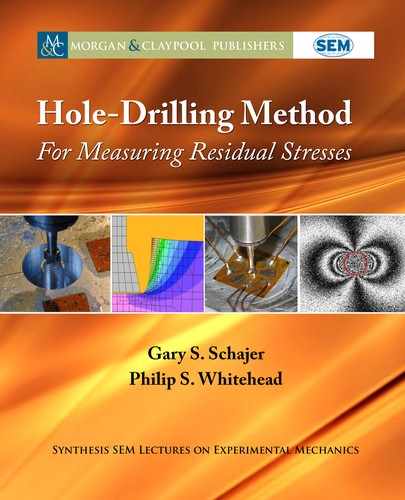8 1. NATURE AND SOURCE OF RESIDUAL STRESSES
of the temperature at the core is much slower. As cooling proceeds, the imbalance of temper-
atures and associated dimensions between the core and skin results in generally tensile residual
stresses at the core and balancing compressive stresses at the skin. Depending on the material,
temperature ranges and quench medium, residual stresses can approach or exceed the material
yield strength. In extreme circumstances, stresses during the quenching process can exceed the
material yield strength or the ultimate strength resulting in fracture and partial relaxation of the
residual stresses.
Composite materials bring into play a further mechanism for thermal stress development.
In general, the individual materials within a composite structure have different physical proper-
ties. us, differences in thermal properties produce differential expansions among the various
materials, causing dimensional misfits and consequent residual stresses. If large, the stresses can
cause permanent deformations and associated residual stresses. Smaller residual stresses may also
occur in the elastic range and vary approximately linearly with overall temperature. ese latter
stresses are temporary insofar as a temperature cycle that returns to the starting temperature pro-
duces residual stresses that similarly cycle and return to the starting stress state. In some cases,
there may be a particular temperature, perhaps corresponding to the manufacture temperature,
at which the residual stresses become close to zero. is same mechanism occurs on a much
larger scale with the structural stresses previously considered. For thermal stresses in railway
rails, the zero-stress temperature is called the “rail neutral temperature.” Similar behaviors can
occur on a microscopic scale, where residual stresses of significant size can occur in and around
inclusions and crystal grains in metals.
1.3.3 NON-UNIFORM PLASTIC DEFORMATION
Residual stresses are created in nearly all material forming and shaping procedures, for example,
bending sheet metal to make boxes, spin forming (stretching) metal to make bowls, and twisting
wires to assemble into cables. All such processes involve substantial plastic deformation so as to
change the shape of the workpiece permanently. Almost invariably the associated plastic strains
are non-uniform, and so therefore create the localized material misfits that produce residual
stresses.
Figure 1.8 illustrates residual stress formation in a beam that is bent beyond its elastic
range. For simplicity, the material here is assumed to be elastic-perfectly plastic. Figure 1.8a
shows the maximum stress distribution within the material cross-section that can occur in the
linear elastic range. e maximum stresses at the surfaces just reach the yield stress. On further
bending in Figure 1.8b the material near the outer surfaces yields and deforms plastically at con-
stant stress to produce the outer flat areas in the stress profile. e inner linear area remains in
the elastic range. If the beam is then unloaded, elastic stress release corresponding to the dashed
line in Figure 1.8b occurs. A surface stress greater than yield is required to give a linear stress dis-
tribution with equal moment resultant to the plastic stress distribution. is larger elastic stress
change can occur because the available elastic unloading range spans from tensile yield, through

1.3. SOURCES OF RESIDUAL STRESSES 9
zero to compressive yield and thus is twice the size of the elastic loading range. Figure 1.8c shows
the residual stress resultant that remains after the elastic unloading. It corresponds to the plastic
stress profile in Figure 1.8b minus the linear elastic unloading stress profile.
–σ
y
–σ
y
σ
y
σ
y
(a) (b) –σ
y
σ
y
(c)
–σ
y
–σ
y
σ
y
σ
y
(d) (e) –σ
y
σ
y
(f )
Figure 1.8: Residual stress creation and relief in a beam of elastic-perfectly plastic material.
Shaded areas D plastic deformation. (a) Bending in elastic range, (b) bending into plastic range,
dashed line D elastic moment resultant, (c) residual stresses after release of bending load, (d) ad-
dition of axial tension, (e) further addition of axial tension with plastic deformation, and (f) fur-
ther addition of axial tension with full plastic deformation.
e bending process in Figure 1.8 illustrates a common feature of loading processes that
create residual stresses. If the beam in Figure 1.8 were reloaded, it would reload elastically until
it reached the plastic stress state previously reached during the prior loading in Figure 1.8b be-
fore further plastic deformation could occur. is is a larger applied load range than was initially
available in Figure 1.8a. us, the residual stresses in Figure 1.8c are seen to have a strength-
ening effect. Similar behavior occurs with other loading types and such controlled overloading
is often used as a means of strengthening against subsequent loads in the same direction. For
example, cold hole expansion is commonly used to strengthen holes by controlled plastic over-
loading of the hole edge. Similarly, flywheels can be strengthened by initial running over-speed.
e process of over-pressuring cylinders, called “autofrettage,” is long-established as a method
for strengthening cannons for military use. In all these examples, it should be noted that the
..................Content has been hidden....................
You can't read the all page of ebook, please click here login for view all page.
